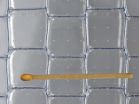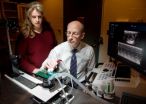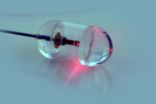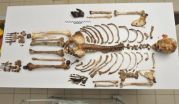(Press-News.org) Too much noise causes illness. This is as an undisputed fact nowadays, and yet we're still constantly assailed by noise as we go about our daily lives, be it from traffic or voices in large open-plan offices. Noise pollution can be reduced with the help of structural solutions; we've all seen noise barriers along busy roads and train lines, and there are special acoustic structural components, so-called sound absorbers, which are used inside buildings to keep noise levels down. But there's a problem. The construction components used up until now may well be effective at reducing noise, but they are not often very functional. Architects who incorporate soundproofing measures into their designs often complain about the inflexibility of modern materials. Limiting factors that affect the choice of material include weight, fire resistance or the hygienic requirements involved when designing large-scale kitchens or laboratories. After all there's also an aesthetic aspect; hardly anyone would say that a solid concrete wall along a road was attractive.
Scientists at the Fraunhofer Institute for Building Physics IBP are working on new solutions. "One of the main things we are focusing on developing is microperforated construction components. This technology is suitable for all types of material and enables the production of multifunctional, visually appealing sound absorbers that can be used for a flexible range of applications," explains Prof. Dr. Philip Leistner, acting institute director and head of the acoustics department at the IBP. Microperforated absorbers consist of membranes or sheets that have been perforated with a multitude of tiny holes or slits. When sound waves strike the surface as oscillating air molecules, friction is generated between the air in motion and the edge of the miniscule openings. It is this loss of energy that results in the sound being absorbed. The only prerequisite is that there is an air chamber located behind the openings, to allow the molecules to continue oscillating once they have passed through, as otherwise the sound would simply be reflected. Depending on the material, the holes are drilled, punched or pricked. "Above all, it's a question of cost efficiency," explains Prof. Leistner. "When it comes to ensuring the manufacturing process is cost-effective, it's important to realize that not all methods are equally well suited for every material." For it goes without saying that despite all the advantages they offer, sound absorbers must also remain affordable. Stuttgart staff and their industrial partners have already worked together to develop a whole generation of market-ready microperforated acoustic construction components. The technology means that, for the first time, it is possible to make sound absorbers that are both transparent and translucent. When mounted onto building façades or as noise barriers at the roadside, these materials have the desired effect without detracting from the landscape, and they can also be superbly integrated into the interior architecture of buildings.
Elastic surfaces for hygiene-sensitive areas
New additions to the sound absorber family are expected thanks to the latest developments at the IBP. Scientists there are working on elastic surfaces that are made of tubes arranged side by side, with microscopically small spaces in between. "It's a bit like having a brush with bristles that are enhanced by little extra attachments at the ends – only much denser," explains Prof. Leistner. Such a pliable surface means even micro-holes can be cleaned easily, making it a material that is particularly suitable for use in hygiene-sensitive areas. Extrusion technology has proved especially cost-effective for large-scale applications. This method produces a two-dimensional surface profile with micro-slits, air chambers and base plate by pressing materials such as plastic or aluminum through a shaped nozzle. In the same way as with window and façade profiles, this creates finished, one-piece absorber components that come off the production line as a continuous length of material, eradicating the need for complicated mounting procedures which proved often more expensive than the material itself. Fraunhofer scientists will be presenting prototypes of these new developments alongside tried and tested solutions at the BAU 2013 construction trade fair from January 14-19 in Munich (Hall C2, Booth 131/135).
INFORMATION:
Noise protection – multifunctional and aesthetical
2013-01-14
ELSE PRESS RELEASES FROM THIS DATE:
Can acupuncture improve exercise performance and post-exercise recovery?
2013-01-14
New Rochelle, NY, January 14, 2013—The effects of acute acupuncture applied during exercise on performance factors such as power and blood pressure and on the body's ability to recover post-exercise were evaluated in a review article published in The Journal of Alternative and Complementary Medicine, a peer-reviewed journal from Mary Ann Liebert, Inc., publishers. The article is available free on the Journal website at http://www.liebertpub.com/acm.
A review of the literature uncovered four studies designed to test whether a person receiving acupuncture while exercising ...
Stem-cell approach shows promise for Duchenne muscular dystrophy
2013-01-14
CHAMPAIGN, Ill. — Researchers have shown that transplanting stem cells derived from normal mouse blood vessels into the hearts of mice that model the pathology associated with Duchenne muscular dystrophy (DMD) prevents the decrease in heart function associated with DMD.
Their findings appear in the journal Stem Cells Translational Medicine.
Duchenne muscular dystrophy is a genetic disorder caused by a mutation in the gene for dystrophin, a protein that anchors muscle cells in place when they contract. Without dystrophin, muscle contractions tear cell membranes, leading ...
Social networks may inflate self-esteem, reduce self-control
2013-01-14
PITTSBURGH/NEW YORK—January 14, 2013— Users of Facebook and other social networks should beware of allowing their self-esteem—boosted by "likes" or positive comments from close friends—to influence their behavior: It could reduce their self-control both on and offline, according to an academic paper by researchers at the University of Pittsburgh and Columbia Business School that has recently been published online in the Journal of Consumer Research.
Titled "Are Close Friends the Enemy? Online Social Networks, Self-Esteem, and Self-Control," the research paper demonstrates ...
Fox Chase researchers discover novel role of the NEDD9 gene in early stages of breast cancer
2013-01-14
PHILADELPHIA, PA (January 14, 2013)—Breast cancer is the second leading cause of cancer deaths among women in the United States. Many of these deaths occur when there is an initial diagnosis of invasive or metastatic disease. A protein called NEDD9—which regulates cell migration, division and survival—has been linked to tumor invasion and metastasis in a variety of cancers. Researchers at Fox Chase Cancer Center have now shown that NEDD9 plays a surprising role in the early stages of breast tumor development by controlling the growth of progenitor cells that give rise to ...
Pill-sized device provides rapid, detailed imaging of esophageal lining
2013-01-14
Physicians may soon have a new way to screen patients for Barrett's esophagus, a precancerous condition usually caused by chronic exposure to stomach acid. Researchers at the Wellman Center for Photomedicine at Massachusetts General Hospital (MGH) have developed an imaging system enclosed in a capsule about the size of a multivitamin pill that creates detailed, microscopic images of the esophageal wall. The system has several advantages over traditional endoscopy.
"This system gives us a convenient way to screen for Barrett's that doesn't require patient sedation, a ...
The secrets of a tadpole's tail and the implications for human healing
2013-01-14
Scientists at The University of Manchester have made a surprising finding after studying how tadpoles re-grow their tails which could have big implications for research into human healing and regeneration.
It is generally appreciated that frogs and salamanders have remarkable regenerative capacities, in contrast to mammals, including humans. For example, if a tadpole loses its tail a new one will regenerate within a week. For several years Professor Enrique Amaya and his team at The Healing Foundation Centre in the Faculty of Life Sciences have been trying to better understand ...
Cancer suppressor gene links metabolism with cellular aging
2013-01-14
PHILADELPHIA - It is perhaps impossible to overstate the importance of the tumor suppressor gene p53. It is the single most frequently mutated gene in human tumors. p53 keeps pre-cancerous cells in check by causing cells, among other things, to become senescent – aging at the cellular level. Loss of p53 causes cells to ignore the cellular signals that would normally make mutant or damaged cells die or stop growing.
In short, the p53 pathway is an obvious and attractive target for drug developers. But that strategy has so far proven difficult, as most p53 regulatory proteins ...
The genome of diamondback moth provides new clues for sustainable pest management
2013-01-14
January 13, 2013, Fujian and Shenzhen, China- An international research consortium, led by Fujian Agriculture, Forestry University (FAFU) and BGI, has completed the first genome sequence of the diamondback moth (DBM), the most destructive pest of brassica crops. This work provides wider insights into insect adaptation to host plant and opens new ways for more sustainable pest management. The latest study was published online today in Nature Genetics.
The diamondback moth (Plutella xylostella) preferentially feeds on economically important food crops such as rapeseed, cauliflower ...
What did our ancestors look like?
2013-01-14
A new method of establishing hair and eye colour from modern forensic samples can also be used to identify details from ancient human remains, finds a new study published in BioMed Central's open access journal Investigative Genetics. The HIrisPlex DNA analysis system was able to reconstruct hair and eye colour from teeth up to 800 years old, including the Polish General Wladyslaw Sikorski (1881 to 1943) confirming his blue eyes and blond hair.
A team of researchers from Poland and the Netherlands, who recently developed the HIrisPlex system for forensic analysis, have ...
New study reveals gas that triggers ozone destruction
2013-01-14
Scientists at the Universities of York and Leeds have made a significant discovery about the cause of the destruction of ozone over oceans.
They have established that the majority of ozone-depleting iodine oxide observed over the remote ocean comes from a previously unknown marine source.
The research team found that the principal source of iodine oxide can be explained by emissions of hypoiodous acid (HOI) – a gas not yet considered as being released from the ocean – along with a contribution from molecular iodine (I2).
Since the 1970s when methyl iodide (CH3I) was ...




